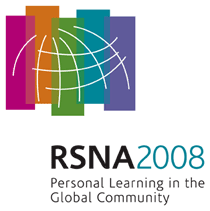
Abstract Archives of the RSNA, 2008
SSM09-02
Noninvasive Quantification of Hepatic Steatosis with 3.0 Tesla Magnetic Resonance Spectroscopy in Patients Undergoing Liver Resection
Scientific Papers
Presented on December 3, 2008
Presented as part of SSM09: Gastrointestinal (Liver: Fatty Liver)
Jochem Reinier Van Werven MD, Presenter: Nothing to Disclose
H. A. Marsman MD, Abstract Co-Author: Nothing to Disclose
A. J. Nederveen PhD, Abstract Co-Author: Nothing to Disclose
F. J. ten Kate MD, PhD, Abstract Co-Author: Nothing to Disclose
T. M. van Gulik MD, PhD, Abstract Co-Author: Nothing to Disclose
Jaap Stoker MD, PhD, Abstract Co-Author: Research support, Koninklijke Philips Electronics NV
Hepatic steatosis has been identified as a risk factor in liver surgery or living donor liver transplantation. Liver biopsy is the gold standard for assessment of hepatic steatosis. Proton Magnetic Resonance Spectroscopy (¹H-MRS) could be a non-invasive alternative to liver biopsy. Therefore, the purpose of this study was to quantify hepatic steatosis with ¹H-MRS in patients undergoing liver resection.
¹H-MRS was performed preoperatively in 27 patients undergoing liver resection. Intraoperatively liver biopsies were taken for histopathological and biochemical analysis. ¹H-MRS measurements were performed at 3.0 T. A ratio representing hepatic fat was calculated from CH2 fat peak versus the reference H2O peak, and correlated (Spearman correlation coefficient) with histopathological hepatic steatosis and biochemical fatty acid concentration in the liver. ¹H-MRS measurements were compared in a spectrum of patients with hepatic steatosis to investigate discriminative power (Mann-Whitney U analysis).
15 males and 12 females were included, with mean age of 57.6 years. At histopathology 16 patients had mild (0-33%), 7 had moderate (33-66%) and 4 had severe (>66%) hepatic steatosis. ¹H-MRS measurements of hepatic fat showed strong correlation with histopathological hepatic steatosis assessment (r= 0.81, p< 0.001). ¹H-MRS also correlated with biochemical fatty acid concentration (r= 0.85, p<0.001). Comparison of ¹H-MRS measurements between patients with different steatosis grades showed significant differences: mild versus moderate (p= 0.001), moderate versus servere (p=0.024), and mild versus severe hepatic steatosis (p=0.001).
¹H-MRS is able to accurately measure hepatic steatosis in patients and strongly correlates with histopathological and biochemical hepatic fat analysis. ¹H-MRS is also able to accurately discriminate between different grades of hepatic steatosis. Therefore, ¹H-MRS is a promising modality for non-invasive preoperative assessment of hepatic steatosis in patients undergoing major liver surgery.
¹H-MRS is a good modality for non-invasive preoperative assessment of hepatic steatosis.
Van Werven, J,
Marsman, H,
Nederveen, A,
ten Kate, F,
van Gulik, T,
Stoker, J,
Noninvasive Quantification of Hepatic Steatosis with 3.0 Tesla Magnetic Resonance Spectroscopy in Patients Undergoing Liver Resection. Radiological Society of North America 2008 Scientific Assembly and Annual Meeting, February 18 - February 20, 2008 ,Chicago IL.
http://archive.rsna.org/2008/6007727.html

